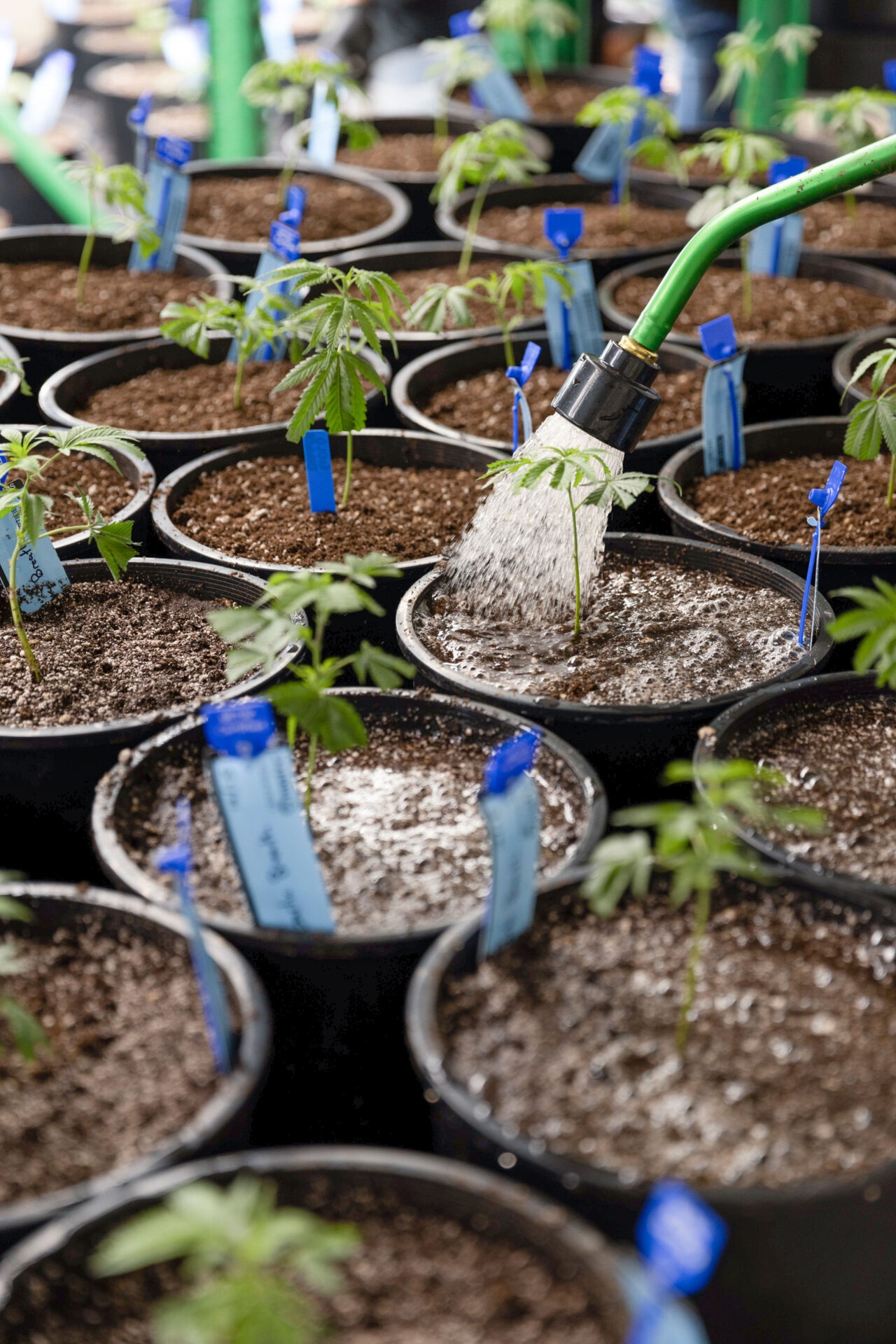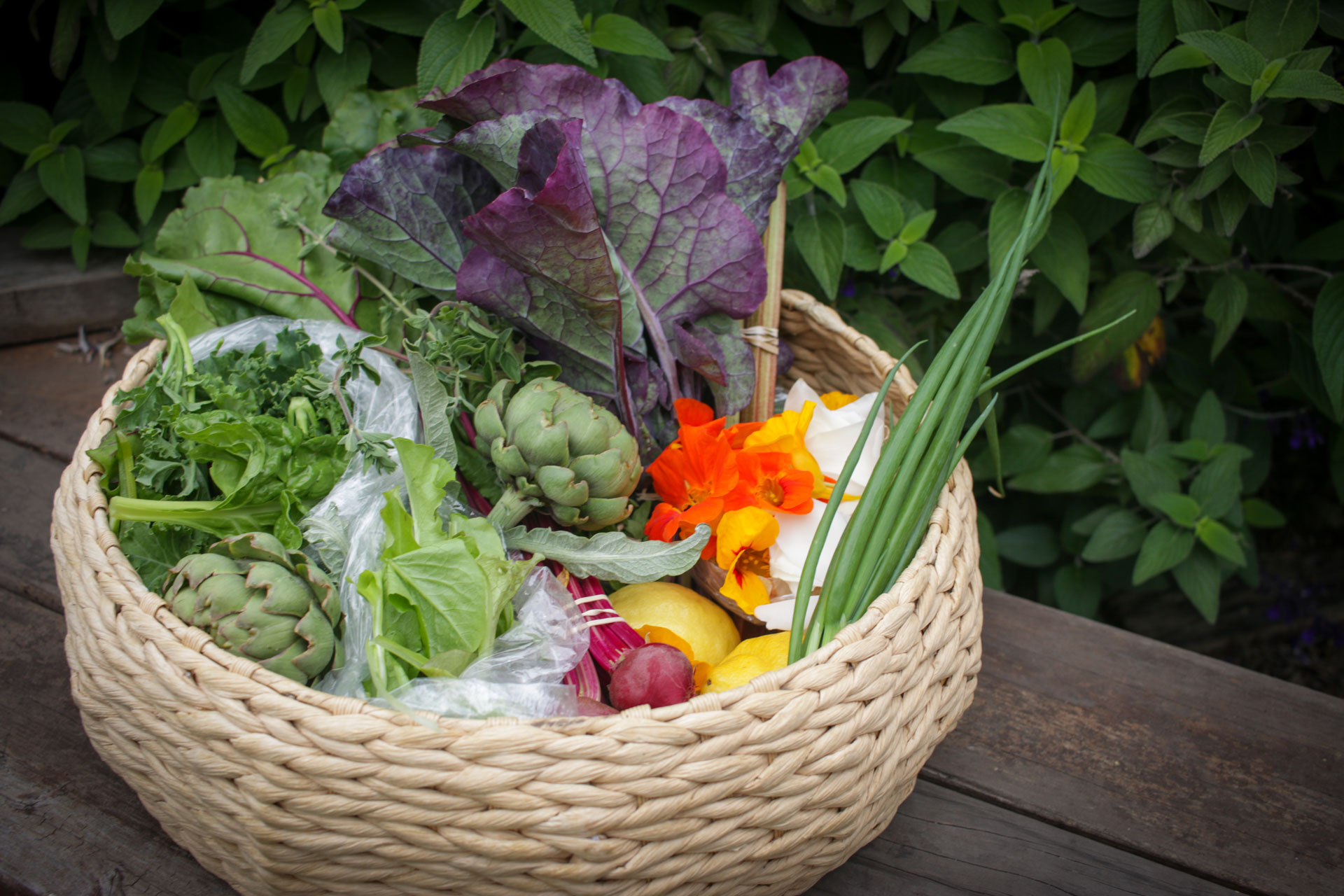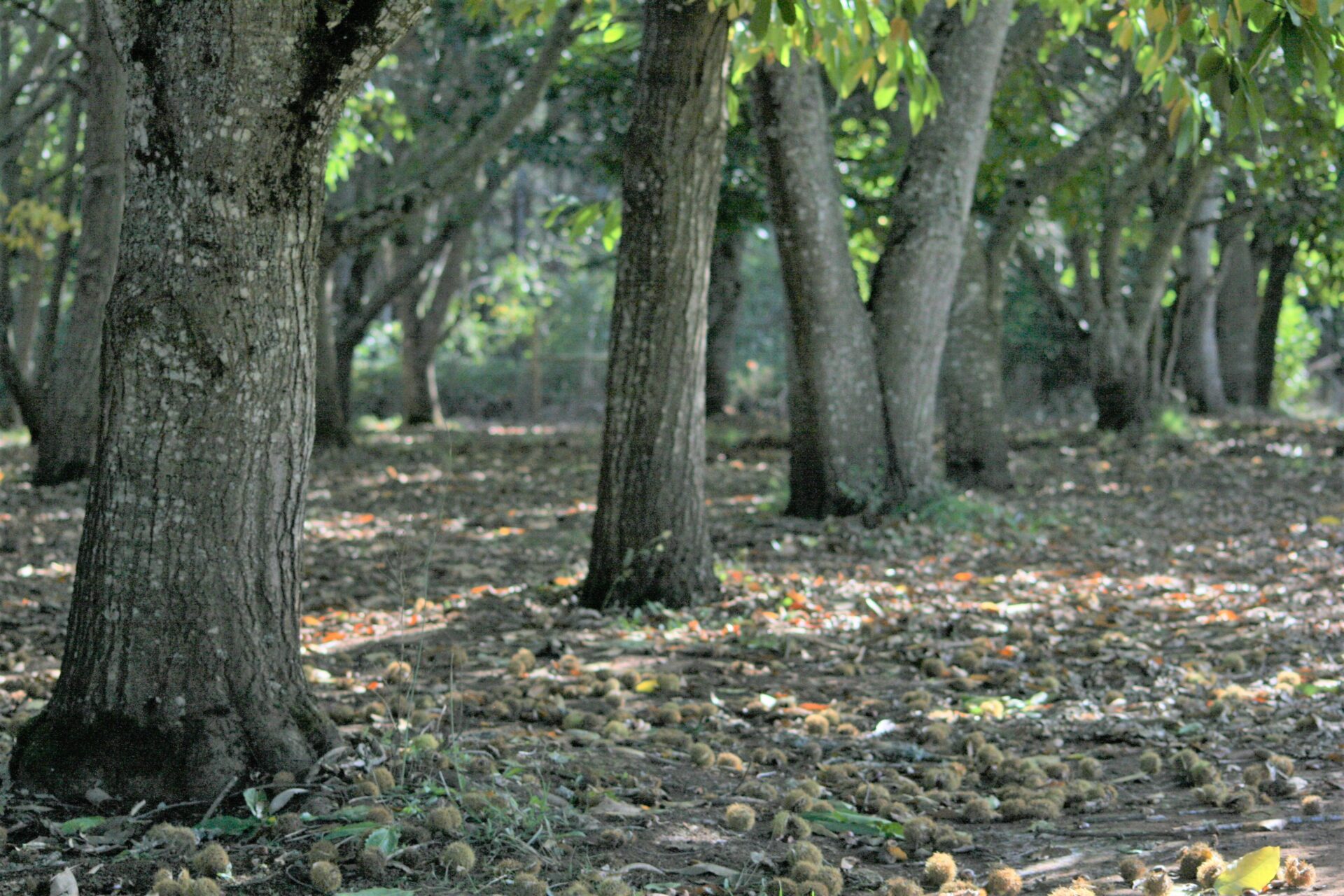Even growers who use conventional farming methods to grow hazelnuts may find some organic methods insightful, even useful. At the Third Annual Oregon Organic Hazelnut Co-op Summer Tour, of course, it was all about growing organically.
Seventy-four people signed up for the tour. West Coast Nut was a sponsor for the event, and provided black fabric bags along with a current issue of the magazine for everyone who attended. The attendees met the morning of August 14, at Skydance Farm on Old Kruger Road in Sherwood, Oregon, to tour Lori and Jerry Stole’s young organic hazelnut orchard.
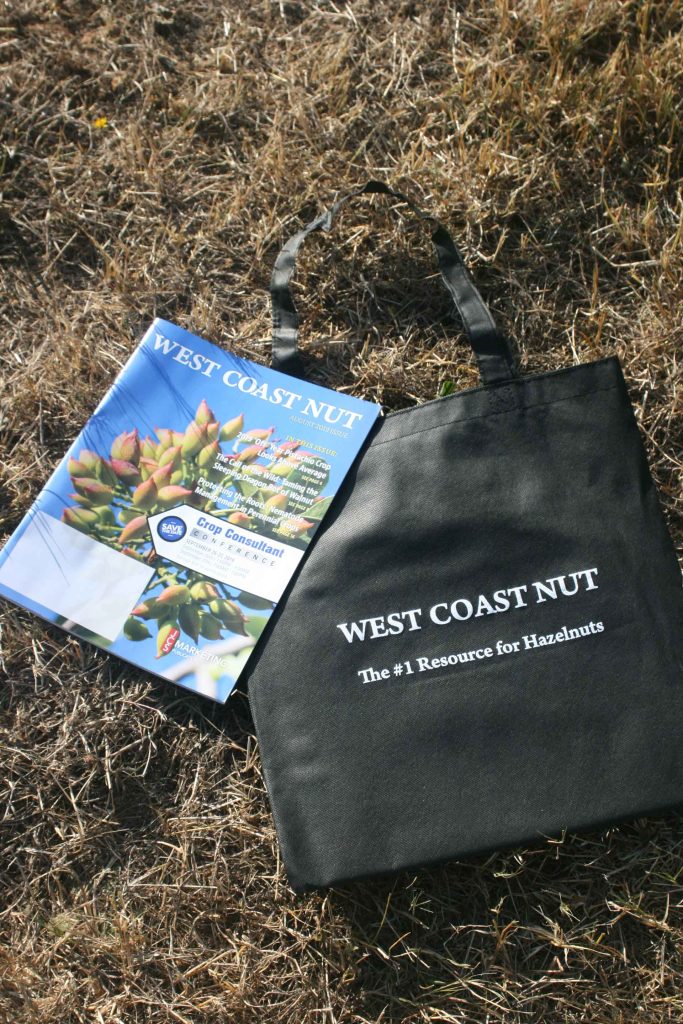
Readying the Land
Lori and Jerry Stole’s five acres of Yamhill hazelnuts is planted beyond a stand of timber behind their house. Jerry grew up on a filbert farm across the road. The couple chose to grow hazelnuts because Jerry already knew the crop, and Lori enjoyed eating hazelnuts when she lived in Germany.
The orchard was planted in cherries 30 years ago. It sat for 20 years and grew wild. The Stoles hired a company to come out and grind the blackberries down. “They were nine to ten-feet tall,” Jerry said.
The orchard is on Laurelwood silt loam and is 30-percent sloped. There are some underground springs, but because the Stoles don’t till the land, Lori said they don’t’ have a problem with drainage. They hand laid some French tile, so there is no issue with standing water.
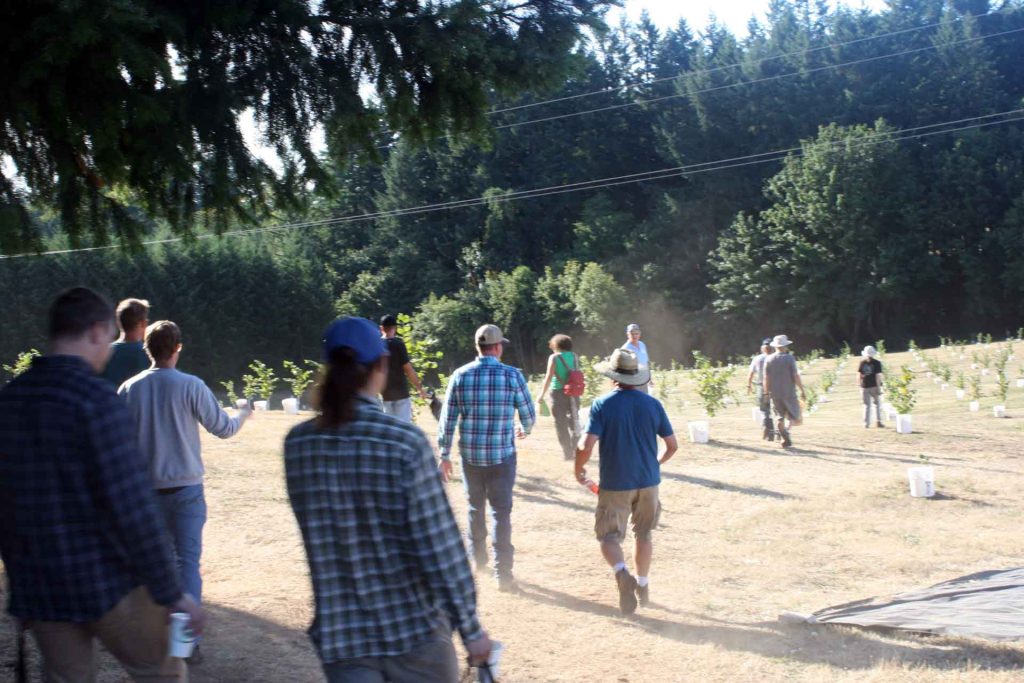
Planting the Orchard Around Power Lines
A large power line runs across the orchard, which is one of the reasons Lori and Jerry settled on Yamhill trees. “They don’t grow as tall, generally,” Lori explained.
The Stoles custom planted their pollinators, which will eventually grow tall, so none of them are growing under the power lines. They selected Wepster, Gamma and York, which are all resistant to Eastern Filbert Blight (EFB). They used a paper diagram with paper circles to plan out placement of pollinators. They had to leave 30 feet on either side of the center of the power poles to appease the power company. Every other row is York, or a mixture of Gamma and Wepster.

Jerry and Lori planted the orchard in a diamond pattern, with 18-foot aisles, offset in 10-foot increments, so they can flail three ways. They decided to plant single density. “We’re happy with our decision,” Lori said. “It helps to be able to flail in many directions.”
Lori said they laid out the orchard with “two tape measures, five people and stakes.” They dug holes one foot deep and 18-20 inches in diameter, and used a board with a notch in the middle to help center each tree. They drove a bamboo stake on either side of the trees. “We learned the technique from Tom Rogers,” Lori said.
Lori, Jerry and their daughter hand planted the 517 trees.
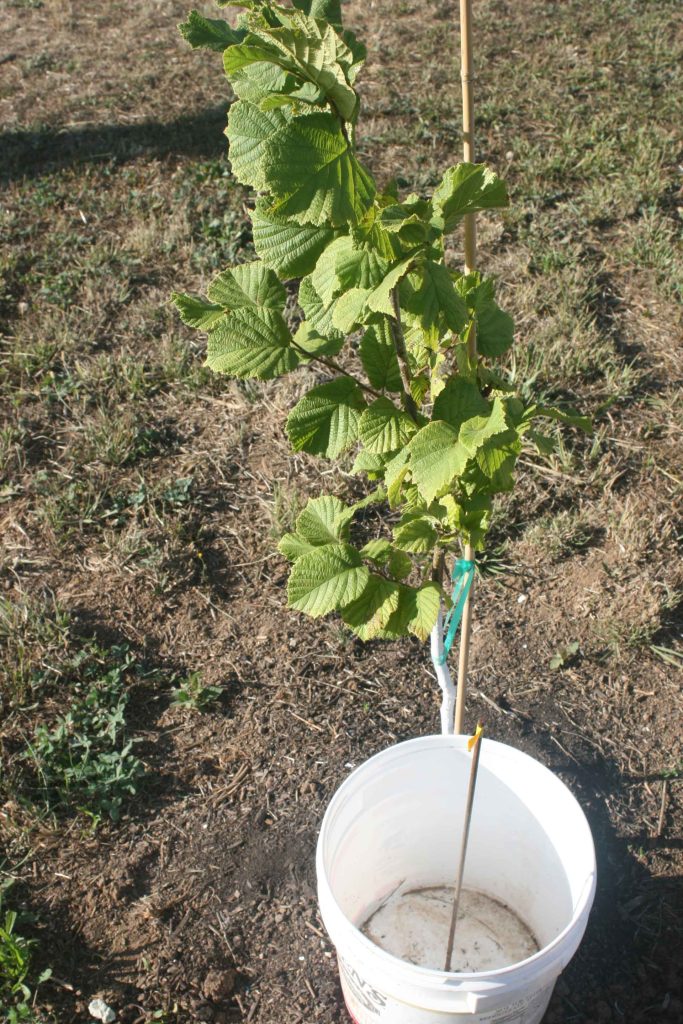
Caring for the Young Trees
The Stoles painted the stems of the trees with milk paint, which is organic. The hazelnut orchard has always been grown using organic methods. They applied to be certified organic three years back, so they can’t use Latex paint. The Stoles mixed one part milk paint to one part water. “Stir or shake. Let it sit for 20 minutes or so,” Lori said, “then it’s ready to go.”
After painting the trunks, the Stoles surrounded the trees with certified organic mulch. They hooked a trailer behind their tractor and had two people with shovels place mulch around the small trees. Some of the mulch has been displaced. “It’s gotten spread around from weed control and gophers,” Lori said.
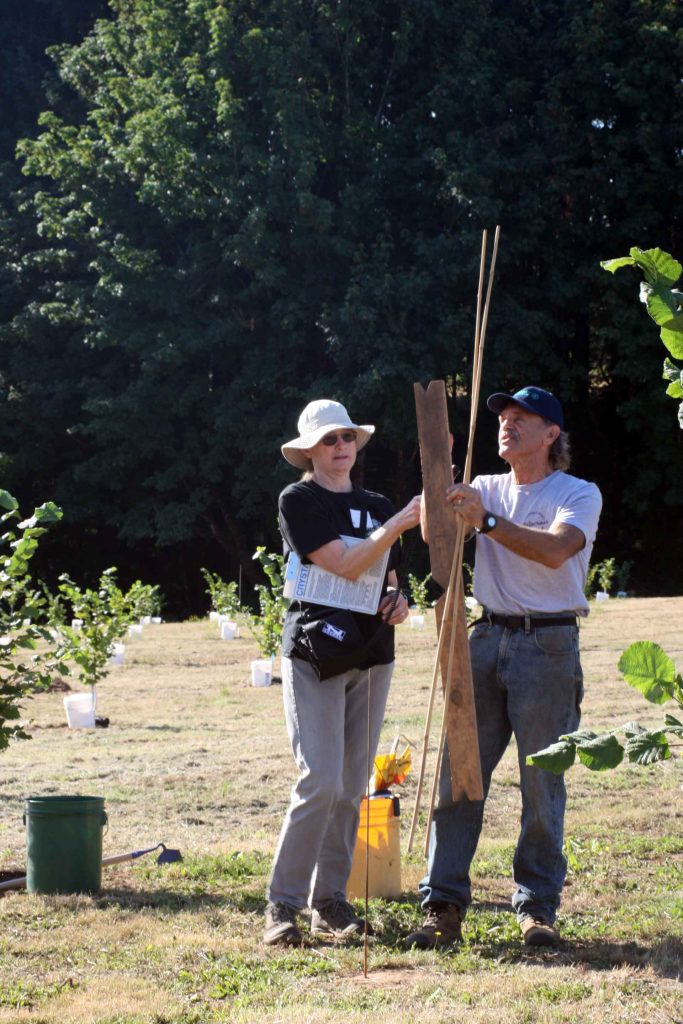
Orchard Maintenance
Jerry uses a 7-foot 4-inch wide flailer and gives the orchard six passes. He also does lots of mowing, but he doesn’t seem to mind. “It helps keep the weeds out,” he said.
There’s a lot of manual labor to growing hazelnuts organically, Lori said. They pull weeds by hand and do a lot of hoeing. Lori said it helps to have a long-handled hoe. She got hers from Red Pig Garden Tools in Boring, Oregon. The company hand-forges and makes customized tools. While the Stoles are weeding around the trees, they go ahead and cut suckers or pull off buds.
Jerry uses a large metal float behind a tractor to level out the orchard floor. He also used the float during field prep.

Pests and Weeds
Gophers, moles and squirrels are also problematic. With the tall stand of trees on either side of the orchard, Lori hopes predators such as great horned owls and red-tailed hawks will help. Jerry plans to install raptor poles. “They also attract owls at night to get voles,” Lori said of the poles.
For additional gopher control, Jerry likes the cinch trap. He said it kills quickly, it’s durable, and it’s handmade in Oregon. He bought his traps online.
Deer have scraped the trunks of some of the trees. Flat-headed borer have caused some damage. Beavers live in a nearby pond; Lori is nervous about them chewing trees.
The couple fenced off an area of the orchard that contained Japanese knotweed. The invasive weed, which has been nicknamed “Godzilla weed,” grows from rhizomes with up to a 30-foot radius under the soil. The more the knotweed is dug or cut, the more it spreads. So for the summer, the Stoles left it alone, not even mowing within the 30-foot radius. They planned to treat the knotweed with an organic herbicide this fall.

Irrigation and Fertilizing
The Stoles used a metal stake to secure a five-gallon bucket near each tree. The buckets have a hole cut in the bottom. Lori and Jerry use a water tank on a trailer to fill the buckets. The tank has a gas-powered trash pump “It’s a two-person operation,” Lori said. “One to drive the tractor and one to water.” One tank waters three rows, and then it’s back to the house to refill. It takes about 30 minutes each trip to refill the tank.
Lori did a tissue test last fall. She planned to do another this fall. Last year, Oregon State University (OSU) laid down a band of liquid lime for fertilizer. They used liquid lime because it acts quickly. “This year the trees look greener,” Lori said, “and happier, I guess.”
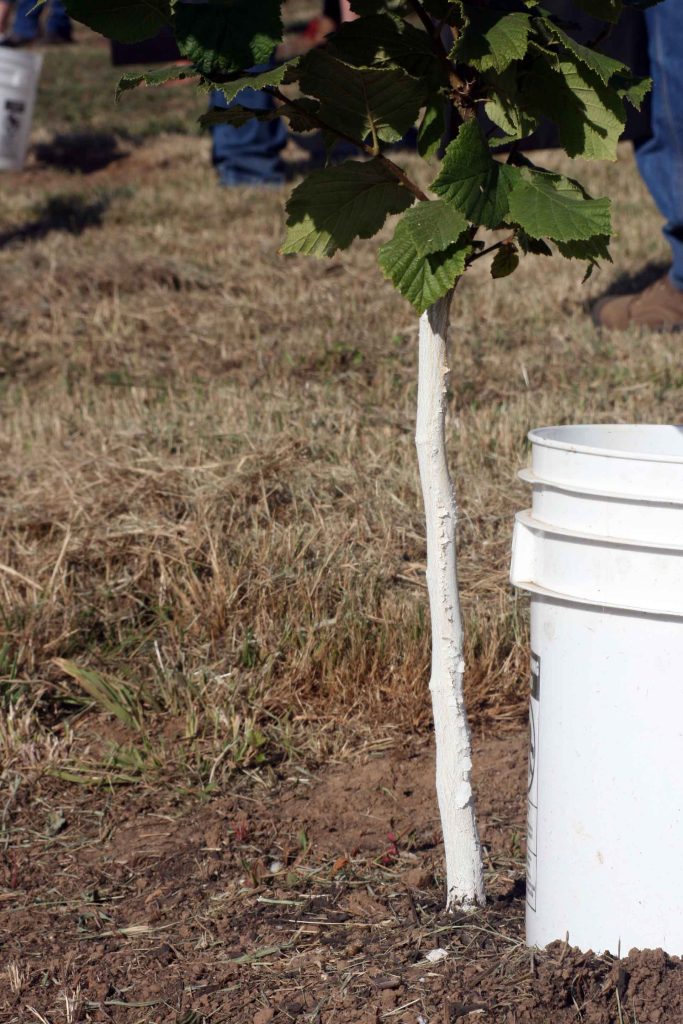
Native Hedge Row
A contractor is planting a hedge row between the Stole’s orchard and the field next door, which is conventionally farmed. A Tualatin Watershed Improvement Grant, or TWIG grant, is funding the project. Ash Creek Forest Management is also helping. The first step is laying down black plastic to get rid of the current vegetation. “To block the sun,” Lori said, “and hopefully the stuff will stop growing.”
As far as the new hedge row, Lori is hoping that by creating the right habitat with native plants, it will attract predator wasps to help with insect pests in the orchard. Plants such as red-flowering currant, camas, blanket flowers and snow berries will likely wind up in the hedge row. Located on the west side of the orchard, they’ll have to choose plants that don’t grow so tall that they block sunlight.
Organic Outlook
Lori and Jerry want to do their part to contribute to sustainability. “Things support things,” Lori said. “If you mess one thing up, it can throw things out of whack.”
Another reason they chose to grow hazelnuts organically? The nearby creek runs into the Tualatin River, so they don’t want to use toxic chemicals. “We don’t want to run poison into the river. We also have hawks. We don’t want to harm them by poisoning gophers. Just want to be more in harmony with nature.”
West Coast Nut was a sponsor of the Third Annual Summer Farm Tour, providing fabric bags and the current issue of West Coast Nut magazine.
Organic Tips
After the tour, other growers in the crowd shared ideas that have worked for them in their organic orchards:
- Feather meal works well as an organic fertilizer.
- Attach a side cutter to your mower for weed and sucker control. Some of the vegetation will have to be cut by hand in the winter, because the side cutter won’t get everything, but it will help.
- Organic herbicides Homeplate and Suppress were mentioned. Homeplate “burns the heck out of whatever you put it on. Lasts about twelve days, then starts growing again,” one grower said. Homeplate seems to stay in solution better than Suppress, said another grower. Also it has a caution label, instead of a warning, she said.
- Oregon State University trained entomologist, Nik Wiman, gave a talk on insects, including parasitoid wasps such as the Samurai Wasp. He said most sprays, including Entrust, are toxic to the wasps. Nik mentioned the Brown Marmorated Stink Bug (BMSB). They have piercing, sucking mouth pieces and a hankering for hazelnuts. The stink bugs lay eggs in clusters on the bottom side of leaves. The eggs are blue-green and barrel shaped.If the eggs are black, they’ve been inhabited by parasitoid wasps. The female wasp will sometimes stay with the eggs to guard them against other predatory wasps. “Our native wasps can attack eggs, but can’t develop in them,” Nick said.
- Overuse of pyrethroids can flare filbert and hazelnut aphid populations. The filbert aphid is the most problematic. Aphids can affect yield by causing poor kernel fill. Nik said the aphids were out early this year, even before bud break. Last year also saw a high population of aphids, even post-harvest. “It’s a game in spring,” he said, “How long can you wait for natural predators to catch up before spraying?”
- Entrust is known to flare mites.
- Marcelo Moretti, of OSU, is doing some work on organic sucker control.
- For weed identification, Marcelo, who is from Brazil and still learning to identify Oregon Willamette Valley weeds, suggested a phone app by Nat Geo called iNaturalist. Take photos and upload them to the app and it will give you identification suggestions.
- AXXE herbicide is similar to Suppress. It requires a certifier to apply. Gets to the cell membrane and bursts it, according to one grower. It’s a contact herbicide, not a systemic. “Try to spray small weeds early, if weather permits,” the grower said.
- Weedslayer is a systemic organic herbicide. It contains clove oil. One grower said he’s had good luck using it on pigweed and grasses. “Will harm Canada thistle,” he said.
- Try to spray hazelnut suckers sooner; when they are three to four inches tall for best results.


